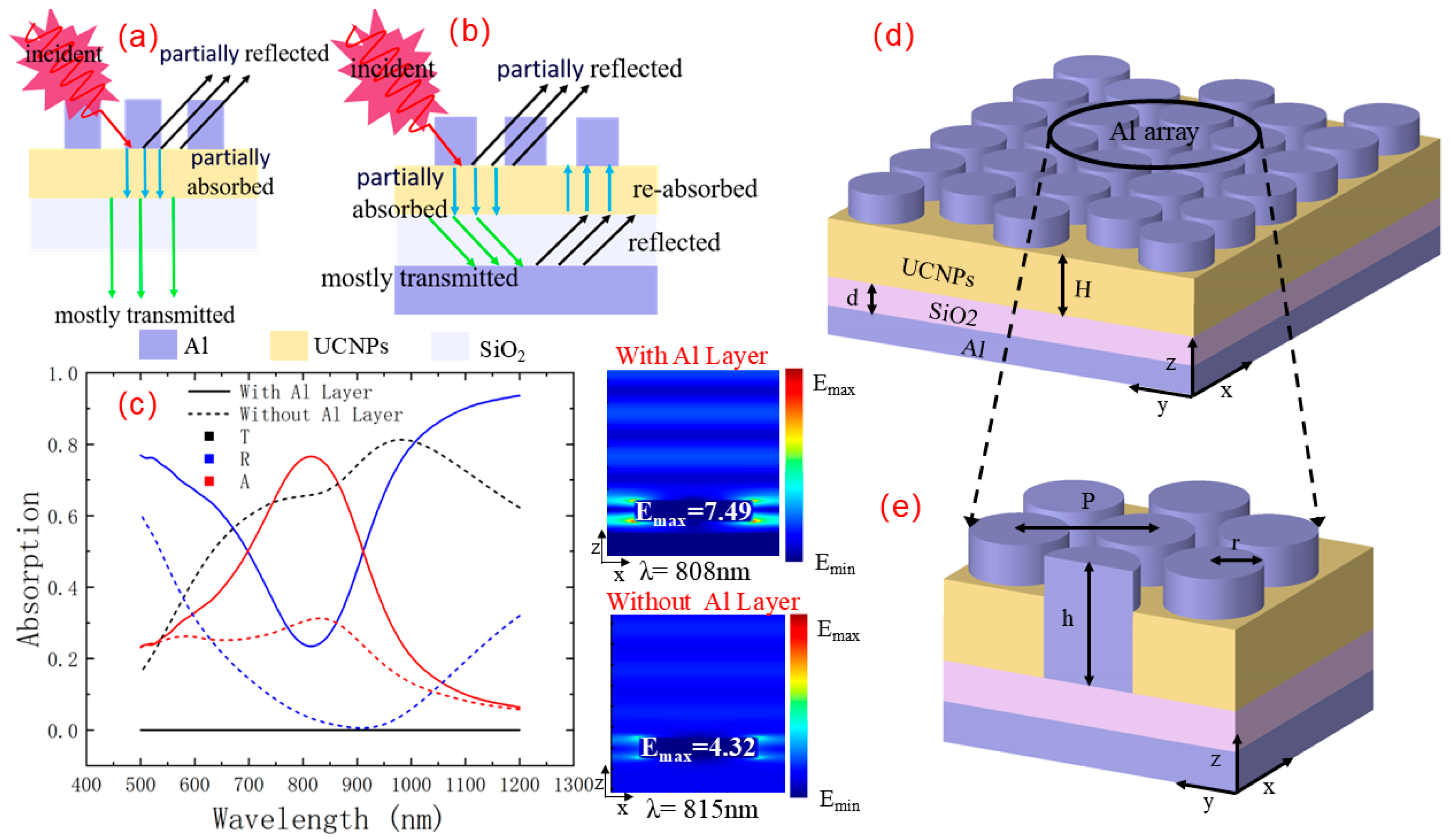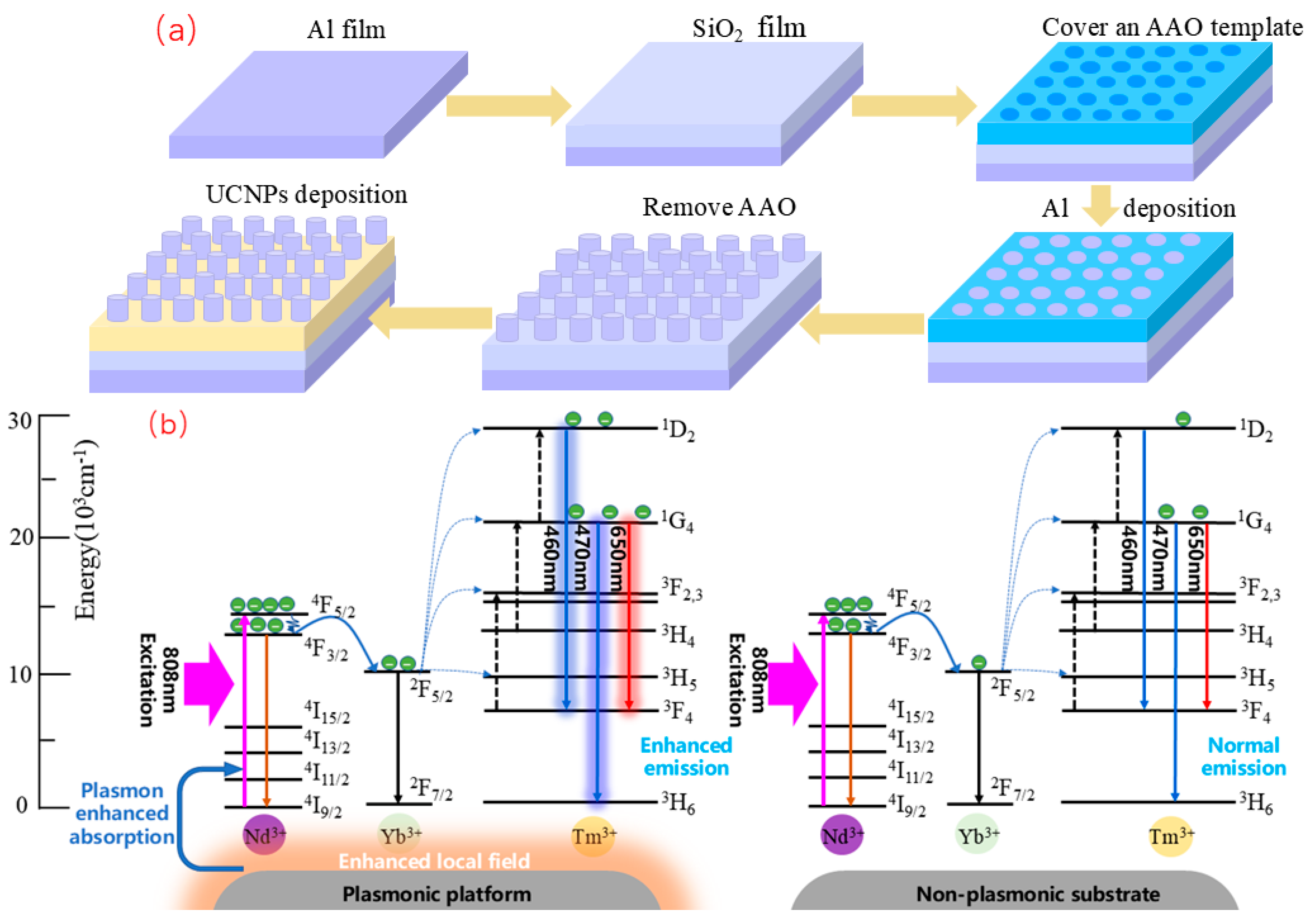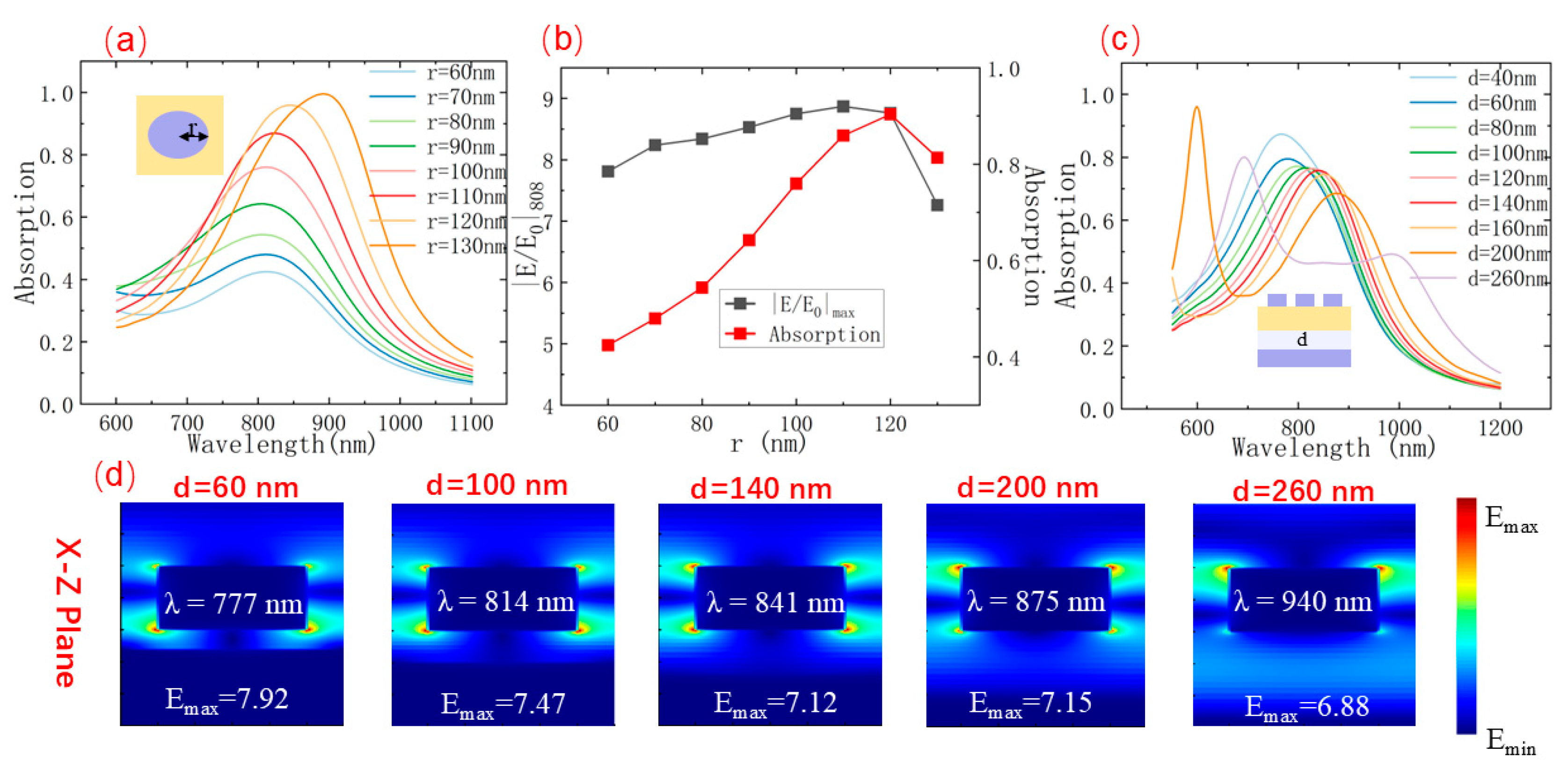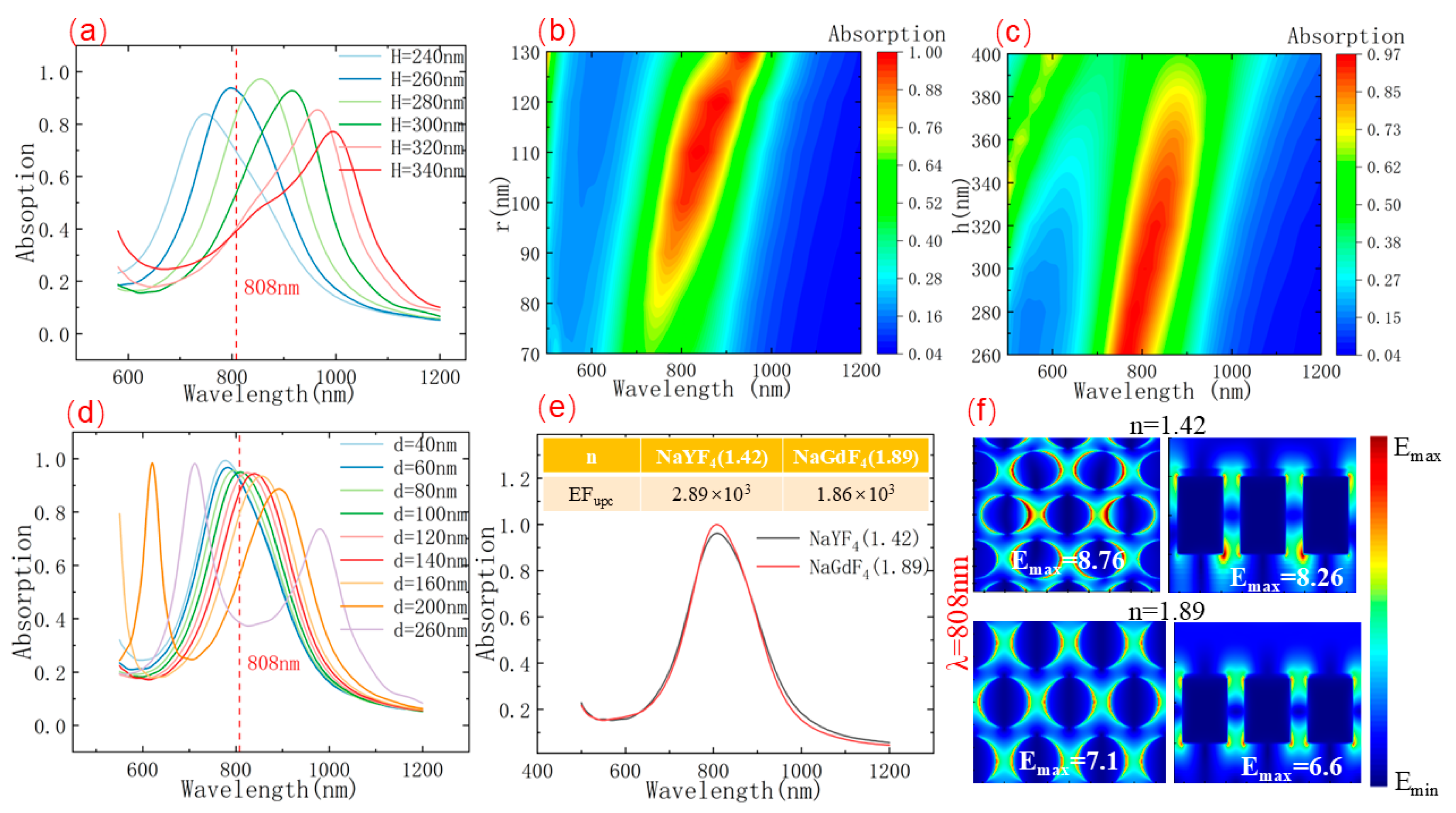Highly Efficient Upconversion Emission Platform Based on the MDM Cavity Effect in Aluminum Nanopillar Metasurface
Abstract
1. Introduction
2. Structure and Model
3. Results and Discussion
4. Conclusions
Author Contributions
Funding
Institutional Review Board Statement
Informed Consent Statement
Data Availability Statement
Conflicts of Interest
References
- Chen, H.; Jiang, Z.; Hu, H.; Kang, B.; Zhang, B.; Mi, X.; Guo, L.; Zhang, C.; Li, J.; Lu, J.; et al. Sub-50-ns ultrafast upconversion luminescence of a rare-earth-doped nanoparticle. Nat. Photonics 2022, 16, 651–657. [Google Scholar] [CrossRef]
- Shwetabh, K.; Banerjee, A.; Poddar, R.; Kumar, K.; Marques-Hueso, J.; Chen, G. Harnessing bright upconversion luminescence from PEG-coated NaGdF4: Ho3+/Yb3+ nanoparticles for contrast enhancement in dual mode OCT imaging and optical temperature sensing. Ceram. Int. 2024, 50, 34956–34965. [Google Scholar] [CrossRef]
- Li, F.; Tu, L.; Zhang, Y.; Huang, D.; Liu, X.; Zhang, X.; Du, J.; Fan, R.; Yang, C.; Chen, G. Size-dependent lanthanide energy transfer amplifies upconversion luminescence quantum yields. Nat. Photonics 2024, 18, 440–449. [Google Scholar] [CrossRef]
- Dubey, N.; Krämer, K.W. Upconversion nanoparticles: Recent strategies and mechanism based applications. J. Rare Earths 2022, 40, 1343–1359. [Google Scholar] [CrossRef]
- Wang, F.; Wen, S.; He, H.; Wang, B.; Zhou, Z.; Shimoni, O.; Jin, D. Microscopic inspection and tracking of single upconversion nanoparticles in living cells. Light Sci. Appl. 2018, 7, 18007. [Google Scholar] [CrossRef]
- Wei, H.L.; Zheng, W.; Zhang, X.; Suo, H.; Chen, B.; Wang, Y.; Wang, F. Tuning Near-Infrared-to-Ultraviolet Upconversion in Lanthanide-Doped Nanoparticles for Biomedical Applications. Adv. Opt. Mater. 2023, 11, 2201716. [Google Scholar] [CrossRef]
- Poliukhova, V.; Kang, M.; Hong, A.R.; Mun, K.R.; Shin, D.; Park, K.W.; Jang, H.S.; Cho, S.H. ZnO/ZnS nanoparticles on NaYF4: Yb3+, Tm3+ for near-infrared-activated photocatalytic Cr (VI) reduction. ACS Appl. Nano Mater. 2022, 5, 14478–14491. [Google Scholar] [CrossRef]
- Yao, W.; Tian, Q.; Wu, W. Tunable emissions of upconversion fluorescence for security applications. Adv. Opt. Mater. 2019, 7, 1801171. [Google Scholar] [CrossRef]
- Mendez-Gonzalez, D.; Melle, S.; Calderón, O.G.; Laurenti, M.; Cabrera-Granado, E.; Egatz-Gómez, A.; López-Cabarcos, E.; Rubio-Retama, J.; Díaz, E. Control of upconversion luminescence by gold nanoparticle size: From quenching to enhancement. Nanoscale 2019, 11, 13832–13844. [Google Scholar] [CrossRef]
- Matias, J.S.; Komolibus, K.; Kiang, W.K.; Konugolu-Venkata-Sekar, S.; Andersson-Engels, S. Beam-profile compensation for quantum yield characterisation of Yb–Tm codoped upconverting nanoparticles emitting at 474 nm, 650 nm and 804 nm. Nanoscale 2024, 16, 3641–3649. [Google Scholar] [CrossRef]
- Rafiei Miandashti, A.; Kordesch, M.E.; Richardson, H.H. Effect of temperature and gold nanoparticle interaction on the lifetime and luminescence of NaYF4: Yb3+: Er3+ upconverting nanoparticles. ACS Photonics 2017, 4, 1864–1869. [Google Scholar] [CrossRef]
- Wen, S.; Zhou, J.; Zheng, K.; Bednarkiewicz, A.; Liu, X.; Jin, D. Advances in highly doped upconversion nanoparticles. Nat. Commun. 2018, 9, 2415. [Google Scholar] [CrossRef] [PubMed]
- Chen, B.; Wang, F. Combating concentration quenching in upconversion nanoparticles. Acc. Chem. Res. 2019, 53, 358–367. [Google Scholar] [CrossRef] [PubMed]
- Zheng, X.; Kankala, R.K.; Liu, C.G.; Wen, Y.; Wang, S.B.; Chen, A.Z.; Zhang, Y. Tailoring lanthanide upconversion luminescence through material designs and regulation strategies. Adv. Opt. Mater. 2022, 10, 2200167. [Google Scholar] [CrossRef]
- Liu, B.; Li, C.; Yang, P.; Hou, Z.; Lin, J. 808-nm-Light-excited lanthanide-doped nanoparticles: Rational design, luminescence control and theranostic applications. Adv. Mater. 2017, 29, 1605434. [Google Scholar] [CrossRef]
- Wiesholler, L.M.; Genslein, C.; Schroter, A.; Hirsch, T. Plasmonic enhancement of NIR to UV upconversion by a nanoengineered interface consisting of NaYF4: Yb, Tm nanoparticles and a gold nanotriangle array for optical detection of vitamin B12 in serum. Anal. Chem. 2018, 90, 14247–14254. [Google Scholar] [CrossRef]
- Das, A.; Bae, K.; Park, W. Enhancement of upconversion luminescence using photonic nanostructures. Nanophotonics 2020, 9, 1359–1371. [Google Scholar] [CrossRef]
- Wu, Y.; Xu, J.; Poh, E.T.; Liang, L.; Liu, H.; Yang, J.K.W.; Qiu, C.; Vallée, R.A.L.; Liu, X. Upconversion superburst with sub-2 μs lifetime. Nat. Nanotechnol. 2019, 14, 1110–1115. [Google Scholar] [CrossRef]
- Ji, Y.; Fang, G.; Shang, J.; Dong, X.; Wu, J.; Lin, X.; Xu, W.; Dong, B. Aligned plasmonic antenna and upconversion nanoparticles toward polarization-sensitive narrowband photodetection and imaging at 1550 nm. ACS Appl. Mater. Interfaces 2022, 14, 50045–50054. [Google Scholar] [CrossRef]
- Liu, X.; Nie, G.; Zhao, K.; Li, H.; Su, X.; Zhan, S. Self-routing dual color nanosource based on the co-excitation via coupling between nano cavities. Results Phys. 2023, 55, 107197. [Google Scholar] [CrossRef]
- Li, H.; Zhao, K.; Liu, X.; Zhan, S.; Nie, G.; Peng, L. Efficient monodisperse upconversion composite prepared using high-density local field and its dual-mode temperature sensing. Phys. Chem. Chem. Phys. 2024, 26, 7398–7406. [Google Scholar] [CrossRef] [PubMed]
- Sun, Q.C.; Casamada-Ribot, J.; Singh, V.; Mundoor, H.; Smalyukh, I.I.; Nagpal, P. Effect of plasmon-enhancement on photophysics in upconverting nanoparticles. Opt. Express 2014, 22, 11516–11527. [Google Scholar] [CrossRef]
- Wang, F.; Martinson, A.B.; Harutyunyan, H. Efficient nonlinear metasurface based on nonplanar plasmonic nanocavities. Acs Photonics 2017, 4, 1188–1194. [Google Scholar] [CrossRef]
- Das, A.; Mao, C.; Cho, S.; Kim, K.; Park, W. Over 1000-fold enhancement of upconversion luminescence using water-dispersible metal-insulator-metal nanostructures. Nat. Commun. 2018, 9, 4828. [Google Scholar] [CrossRef] [PubMed]
- Zhou, D.; Zhang, J.; Tan, C.; Li, L.; Qiu, Q.; Zhang, Z.; Sun, Y.; Zhou, L.; Dai, N.; Chu, J.; et al. Semimetal–dielectric–metal metasurface for infrared camouflage with high-performance energy dissipation in non-atmospheric transparency window. Nanophotonics 2025, 14, 1101–1111. [Google Scholar] [CrossRef] [PubMed]
- Guo, H.; Yang, X.; Zhu, D. Easy-to-Manufacture In-Line 2D Nano Antenna for Enhanced Radiation-Cooled IR Camouflage. Acs Photonics 2023, 10, 1405–1415. [Google Scholar] [CrossRef]
- Liu, H.; Xu, J.; Wang, H.; Liu, Y.; Ruan, Q.; Wu, Y.; Liu, X.; Yang, J.K. Tunable resonator-upconverted emission (TRUE) color printing and applications in optical security. Adv. Mater. 2019, 31, 1807900. [Google Scholar] [CrossRef]
- Kim, S.; Kim, J.M.; Park, J.E.; Nam, J.M. Nonnoble-metal-based plasmonic nanomaterials: Recent advances and future perspectives. Adv. Mater. 2018, 30, 1704528. [Google Scholar] [CrossRef]
- Karpiński, K.; Zielińska-Raczyńska, S.; Ziemkiewicz, D. Aluminium-based plasmonic sensors in ultraviolet. Sensors 2021, 21, 4096. [Google Scholar] [CrossRef]
- Lee, K.L.; You, M.L.; Wei, P.K. Aluminum nanostructures for surface-plasmon-resonance-based sensing applications. ACS Appl. Nano Mater. 2019, 2, 1930–1939. [Google Scholar] [CrossRef]
- Zhu, X.; Zhang, J.; Liu, J.; Zhang, Y. Recent progress of rare-earth doped upconversion nanoparticles: Synthesis, optimization, and applications. Adv. Sci. 2019, 6, 1901358. [Google Scholar] [CrossRef] [PubMed]
- He, L.; Yi, Y.; Zhang, J.; Xu, X.; Tang, B.; Li, G.; Zeng, L.; Chen, J.; Sun, T.; Yi, Z. A four-narrowband terahertz tunable absorber with perfect absorption and high sensitivity. Mater. Res. Bull. 2024, 170, 112572. [Google Scholar] [CrossRef]
- Yang, K.; Yao, X.; Liu, B.; Ren, B. Metallic plasmonic array structures: Principles, fabrications, properties, and applications. Adv. Mater. 2021, 33, 2007988. [Google Scholar] [CrossRef]
- Tang, Z.; Wu, J.; Yu, X.; Hong, R.; Zu, X.; Lin, X.; Luo, H.; Lin, W.; Yi, G. Fabrication of Au nanoparticle arrays on flexible substrate for tunable localized surface plasmon resonance. ACS Appl. Mater. Interfaces 2021, 13, 9281–9288. [Google Scholar] [CrossRef]
- Chen, Z.; Liu, N.; Nie, G.; Li, Y.; Su, X.; Tang, X.; Zeng, Y.; Liu, Y. Numerical demonstration of an efficient up-conversion enhancement strategy by plasmon excitations in a gap-mode nanocavity. Phys. B Condens. Matter 2024, 686, 416073. [Google Scholar] [CrossRef]
- Zhan, S.; Xiong, J.; Nie, G.; Wu, S.; Hu, J.; Wu, X.; Hu, S.; Zhang, J.; Gao, Y.; Liu, Y. Steady State Luminescence Enhancement in Plasmon Coupled Core/Shell Upconversion Nanoparticles. Adv. Mater. Interfaces 2019, 6, 1802089. [Google Scholar] [CrossRef]
- Gong, C.; Liu, W.; He, N.; Dong, H.; Jin, Y.; He, S. Upconversion enhancement by a dual-resonance all-dielectric metasurface. Nanoscale 2019, 11, 1856–1862. [Google Scholar] [CrossRef]
- Lv, R.; Yang, F.; Jiang, X.; Hu, B.; Zhang, X.; Chen, X.; Tian, J. Plasmonic modulated upconversion fluorescence by adjustable distributed gold nanoparticles. J. Lumin. 2020, 220, 116974. [Google Scholar] [CrossRef]
- Sun, L.; Wang, T.; Sun, Y.; Li, Z.; Song, H.; Zhang, B.; Zhou, G.; Zhou, H.; Hu, J. Fluorescence resonance energy transfer between NH2–NaYF4: Yb, Er/NaYF4@ SiO2 upconversion nanoparticles and gold nanoparticles for the detection of glutathione and cadmium ions. Talanta 2020, 207, 120294. [Google Scholar] [CrossRef]
- Qin, X.; Carneiro Neto, A.N.; Longo, R.L.; Wu, Y.; Malta, O.L.; Liu, X. Surface plasmon–photon coupling in lanthanide-doped nanoparticles. J. Phys. Chem. Lett. 2021, 12, 1520–1541. [Google Scholar] [CrossRef]
- Li, X.; Wang, Y.; Shi, J.; Zhao, Z.; Wang, D.; Chen, Z.; Cheng, L.; Lu, G.H.; Liang, Y.; Dong, H.; et al. Large-area near-infrared emission enhancement on single upconversion nanoparticles by metal nanohole array. Nano Lett. 2024, 24, 5831–5837. [Google Scholar] [CrossRef]
- Jung, K. Plasmonic Nanocavity Array for Enhanced Upconversion Luminescence. Bull. Korean Chem. Soc. 2019, 40, 91–92. [Google Scholar] [CrossRef]
- Xue, Y.; Ding, C.; Rong, Y.; Ma, Q.; Pan, C.; Wu, E.; Wu, B.; Zeng, H. Tuning plasmonic enhancement of single nanocrystal upconversion luminescence by varying gold nanorod diameter. Small 2017, 13, 1701155. [Google Scholar] [CrossRef]
- Yin, Z.; Zhou, D.; Xu, W.; Cui, S.; Chen, X.; Wang, H.; Xu, S.; Song, H. Plasmon-enhanced upconversion luminescence on vertically aligned gold nanorod monolayer supercrystals. ACS Appl. Mater. Interfaces 2016, 8, 11667–11674. [Google Scholar] [CrossRef]
- Wei, R.; Xu, T.; Guo, C. High-Efficiency Solar Hybrid Photovoltaic/Thermal System Enabled by Ultrathin Asymmetric Fabry–Perot Cavity. ACS Photonics 2025, 12, 628–635. [Google Scholar] [CrossRef] [PubMed]
- Liu, Y.; Vanacken, J.; Chen, X.; Han, J.; Zhong, Z.; Xia, Z.; Chen, B.; Wu, H.; Jin, Z.; Ge, J. Direct observation of nanoscale light confinement without metal. Adv. Mater. 2018, 31, 1806341. [Google Scholar] [CrossRef]
- Metzger, B.; Hentschel, M.; Giessen, H. Ultrafast nonlinear plasmonic spectroscopy: From dipole nanoantennas to complex hybrid plasmonic structures. ACS Photonics 2016, 3, 1336–1350. [Google Scholar] [CrossRef]
- Saboktakin, M.; Ye, X.; Chettiar, U.K.; Engheta, N.; Murray, C.B.; Kagan, C.R. Plasmonic enhancement of nanophosphor upconversion luminescence in Au nanohole arrays. ACS Nano 2013, 7, 7186–7192. [Google Scholar] [CrossRef]
- Lu, D.; Cho, S.K.; Ahn, S.; Brun, L.; Summers, C.J.; Park, W. Plasmon enhancement mechanism for the upconversion processes in NaYF4: Yb3+, Er3+ nanoparticles: Maxwell versus Forster. ACS Nano 2014, 8, 7780–7792. [Google Scholar] [CrossRef]
- Zhan, S.; Wu, X.; Tan, C.; Xiong, J.; Hu, S.; Hu, J.; Wu, S.; Gao, Y.; Liu, Y. Enhanced upconversion based on the ultrahigh local field enhancement in a multilayered UCNPs-metamaterial composite system. J. Alloys Compd. 2018, 735, 372–376. [Google Scholar] [CrossRef]





Disclaimer/Publisher’s Note: The statements, opinions and data contained in all publications are solely those of the individual author(s) and contributor(s) and not of MDPI and/or the editor(s). MDPI and/or the editor(s) disclaim responsibility for any injury to people or property resulting from any ideas, methods, instructions or products referred to in the content. |
© 2025 by the authors. Licensee MDPI, Basel, Switzerland. This article is an open access article distributed under the terms and conditions of the Creative Commons Attribution (CC BY) license (https://creativecommons.org/licenses/by/4.0/).
Share and Cite
Wu, X.; Mao, X.; Cheng, S.; Li, H.; Zhan, S. Highly Efficient Upconversion Emission Platform Based on the MDM Cavity Effect in Aluminum Nanopillar Metasurface. Photonics 2025, 12, 582. https://doi.org/10.3390/photonics12060582
Wu X, Mao X, Cheng S, Li H, Zhan S. Highly Efficient Upconversion Emission Platform Based on the MDM Cavity Effect in Aluminum Nanopillar Metasurface. Photonics. 2025; 12(6):582. https://doi.org/10.3390/photonics12060582
Chicago/Turabian StyleWu, Xiaofeng, Xiangyuan Mao, Shengbin Cheng, Haiou Li, and Shiping Zhan. 2025. "Highly Efficient Upconversion Emission Platform Based on the MDM Cavity Effect in Aluminum Nanopillar Metasurface" Photonics 12, no. 6: 582. https://doi.org/10.3390/photonics12060582
APA StyleWu, X., Mao, X., Cheng, S., Li, H., & Zhan, S. (2025). Highly Efficient Upconversion Emission Platform Based on the MDM Cavity Effect in Aluminum Nanopillar Metasurface. Photonics, 12(6), 582. https://doi.org/10.3390/photonics12060582



